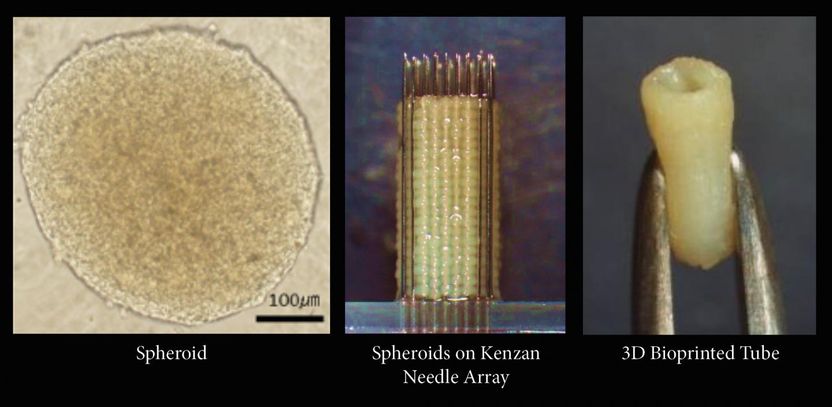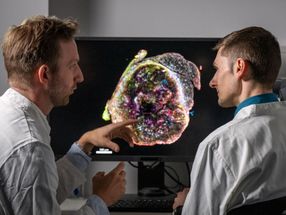New scaffold-free 3-D bioprinting available
Cell Applications, Inc. and Cyfuse Biomedical K.K. have announced that advanced tissue-engineering services are now available in North America using a groundbreaking new three-dimensional (3D) bioprinting approach called the "Kenzan Method." Utilizing Cyfuse Biomedical's Regenova® 3D Bio Printer, a state-of-the-art robotic system that fabricates 3D tissue from cells, Cell Applications has created a powerful pay-for-service bio-printing model that makes scaffold-free tissue available immediately to scientists in the U.S. and Canada for research use.

Cyfuse Biomedical
"In addition to customized cell isolation and assay services, Cell Applications is now able to provide researchers with an integrated cell-engineering solution that utilizes our expansive primary cell bank and the innovative Kenzan bioprinting method," said James Yu, Founder and CEO, Cell Applications. "Having the Regenova 3D Bio Printer at our San Diego headquarters with our vast array of primary cells is a powerful combination. We're very pleased to offer researchers an end-to-end, customized solution for creating scaffold-free, 3D-engineered tissues that reduce costs by minimizing the lengthy processes typical in pharmaceutical drug discovery."
"The Regenova 3D Bio Printer, combined with Cell Applications' comprehensive, high-quality primary cell bank, offers researchers streamlined access to a nearly limitless selection of three dimensional tissues including those mimicking blood vessels, human neural tissue and liver constructs," said Koji Kuchiishi, CEO, Cyfuse Biomedical. "The collective strengths of both our companies will serve the growing demand for viable engineered tissues and accelerate scientific discovery in North America, taking us one step closer to making regenerative medicine a reality."
Unlike other bioprinters currently available, the Regenova does not depend on scaffolding made of biomaterials such a collagen or hydrogel to construct 3D tissue. Instead, the instrument assembles three-dimensional macroscopic tissue by forming aggregates of cells, called spheroids, one at a time and lancing them onto a fine needle array. Pre-programmed software guides the collection of the spheroids, which can then be designed and constructed into small spheres, rods, sheets, tubes or other tissue configurations. As the engineered tissue fully matures during culture in a bioreactor chamber, the individual spheroids fuse with one another into any desired pattern within a range of approximately 10x10x10 millimeter at 500um resolution. Multiple pieces of bioprinted tissue can then be integrated together to form even larger constructs.
As the cells mature, they self-organize, promoting strong, reliable tissue that is further optimized by the design of the bio printer's needle array that allows for optimum circulation of culture medium. The Kenzan Method, meaning "needle array" in Japanese, is a much gentler approach and greatly increases the percentage of viable cells that survive within the 3D construction, in contrast to bioprinting and scaffolding techniques that utilize high-velocity liquid flow which often damage cells and yield insufficient cell numbers.
Using quality-controlled processes, Cell Applications offers more than one hundred types of human and animal primary cells, with nearly 900 configurations including cells freshly isolated or cryopreserved at early passage, with outstanding viability. Additional primary cell types can be isolated through the company's custom services program. The gentle Kenzan Method favors potentially delicate primary cells, which retain important properties of their original tissue systems without genetic or chemical modification, and are therefore often more physiologically relevant than immortalized cell lines. The company's partnership with Cyfuse Biomedical marks the first placement of the Regenova 3D Bio Printer outside of Japan, where Cyfuse has partnered with research universities to utilize the Kenzan Method.
Researchers at biopharmaceutical companies and academic research institutions have been utilizing or evaluating the Kenzan Method for research projects directed toward creating blood vessels, nerve, and functional liver-like tissues. Other anticipated applications include cardiac muscle and pancreatic islets, as well as spinal cord, urologic, trachea, skin and digestive tissues for regenerative medicine research, drug screening, and other basic researches in the pharmaceutical, biotechnology, cosmeceutical and academic research sectors.


























































